Analysis of ALDI's Business and Business Environment Report
VerifiedAdded on 2020/12/10
|15
|4447
|294
Report
AI Summary
This report provides a detailed analysis of ALDI's business environment. It begins by outlining different types of organizations, including private, public, and voluntary sectors, and their respective purposes. The report then delves into the size and scope of these organizations, using ALDI, Crown Prosecution Services, and UNICEF as examples. It further examines the interrelationship between various organizational functions such as human resources, finance, research and development, production, marketing, and sales, highlighting their roles and interdependencies in achieving organizational objectives. The report also explores the positive and negative impacts of the macro environment on business operations, followed by an internal and external analysis of ALDI, including its strengths, weaknesses, and their interrelation with external factors. The report concludes with a discussion of the organizational structure adopted by ALDI and its implications.
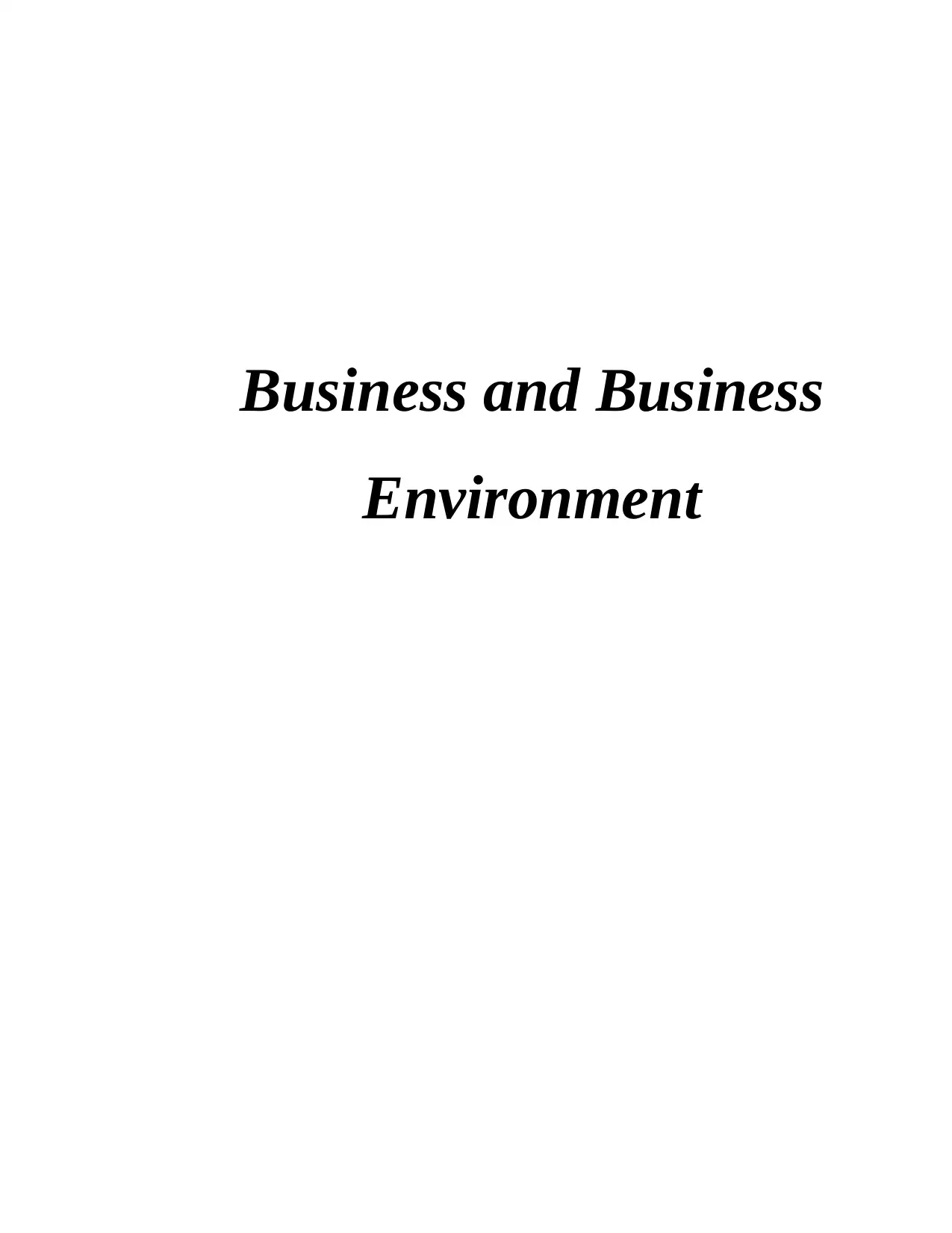
Business and Business
Environment
Environment
Paraphrase This Document
Need a fresh take? Get an instant paraphrase of this document with our AI Paraphraser
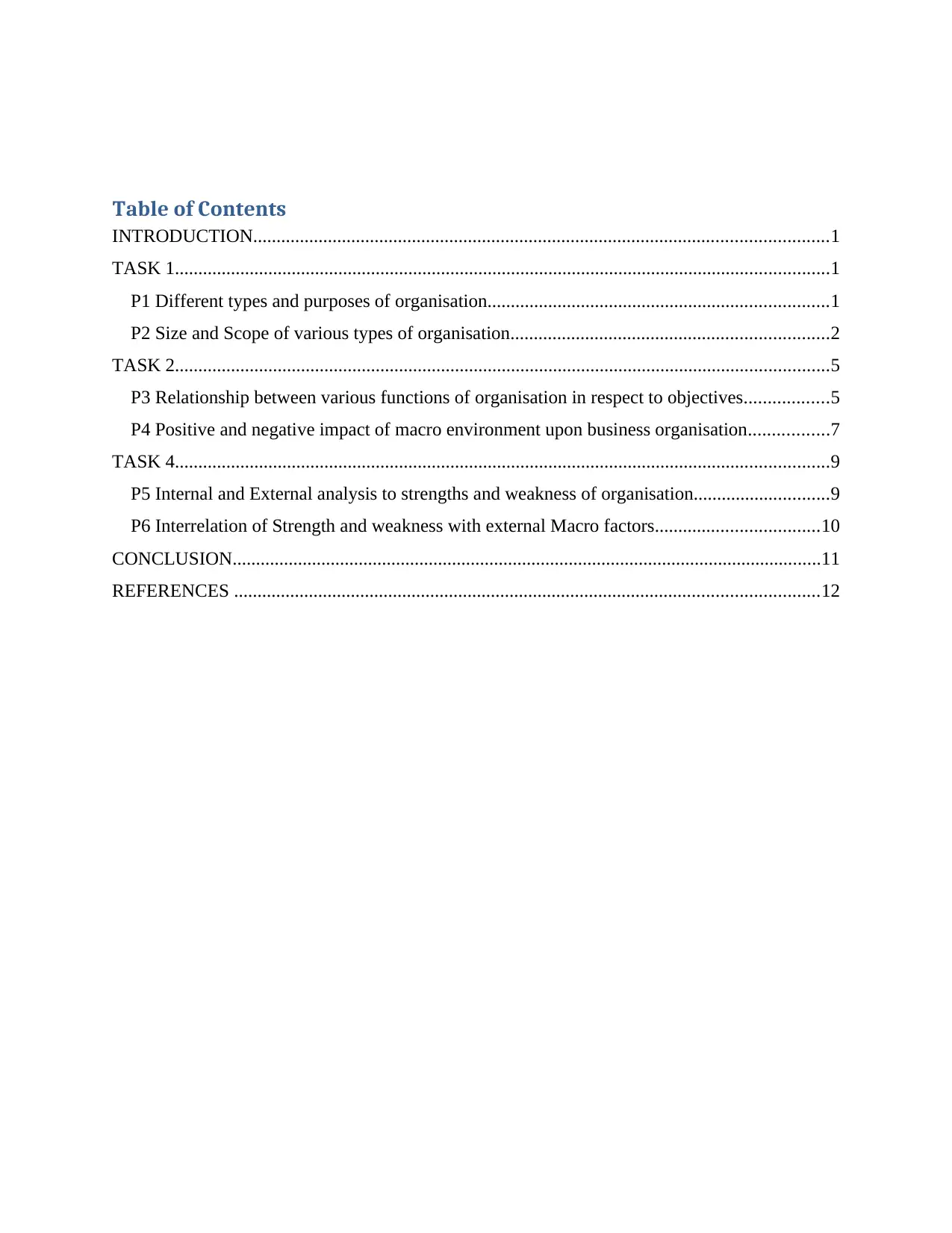
Table of Contents
INTRODUCTION...........................................................................................................................1
TASK 1............................................................................................................................................1
P1 Different types and purposes of organisation.........................................................................1
P2 Size and Scope of various types of organisation....................................................................2
TASK 2............................................................................................................................................5
P3 Relationship between various functions of organisation in respect to objectives..................5
P4 Positive and negative impact of macro environment upon business organisation.................7
TASK 4............................................................................................................................................9
P5 Internal and External analysis to strengths and weakness of organisation.............................9
P6 Interrelation of Strength and weakness with external Macro factors...................................10
CONCLUSION..............................................................................................................................11
REFERENCES .............................................................................................................................12
INTRODUCTION...........................................................................................................................1
TASK 1............................................................................................................................................1
P1 Different types and purposes of organisation.........................................................................1
P2 Size and Scope of various types of organisation....................................................................2
TASK 2............................................................................................................................................5
P3 Relationship between various functions of organisation in respect to objectives..................5
P4 Positive and negative impact of macro environment upon business organisation.................7
TASK 4............................................................................................................................................9
P5 Internal and External analysis to strengths and weakness of organisation.............................9
P6 Interrelation of Strength and weakness with external Macro factors...................................10
CONCLUSION..............................................................................................................................11
REFERENCES .............................................................................................................................12
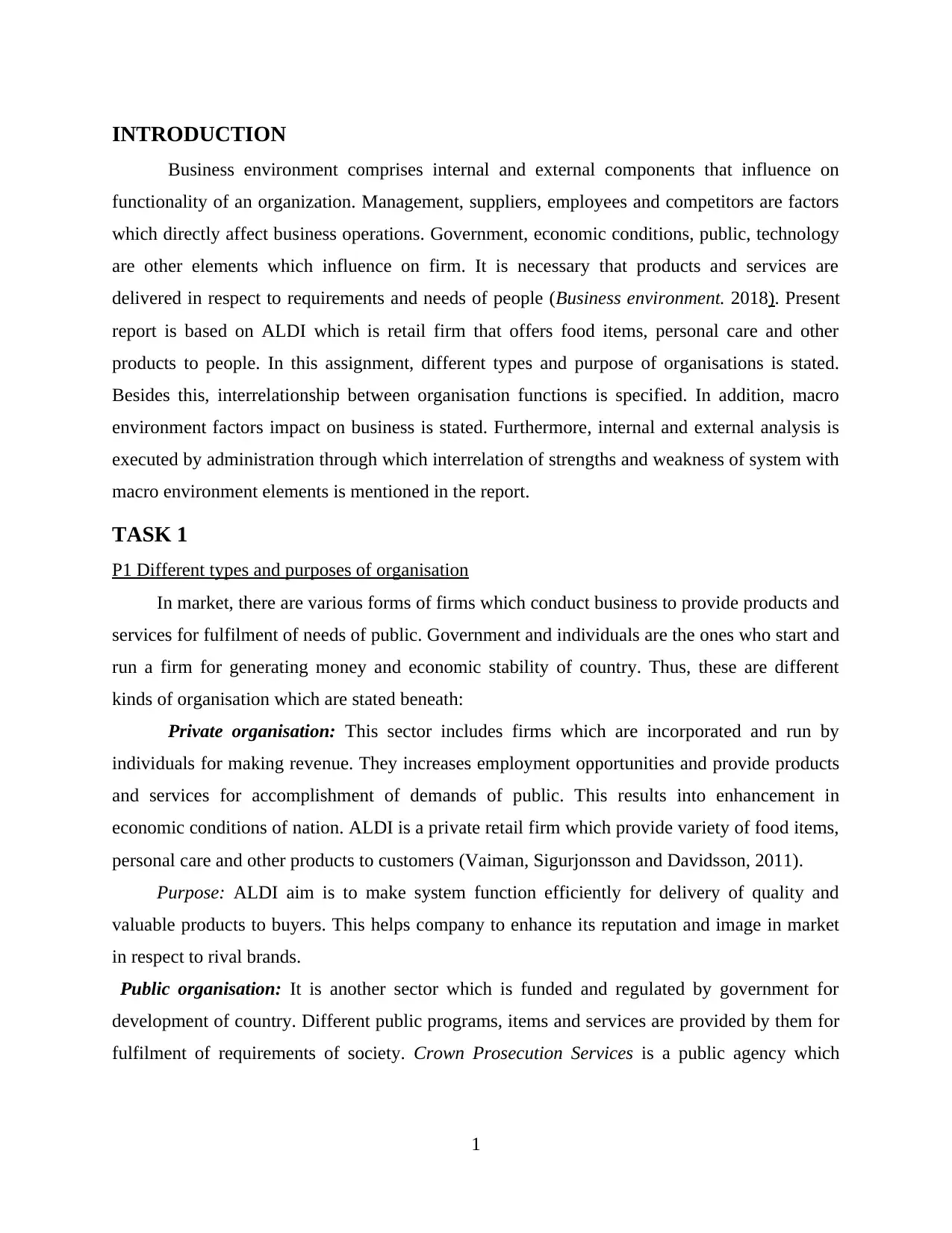
INTRODUCTION
Business environment comprises internal and external components that influence on
functionality of an organization. Management, suppliers, employees and competitors are factors
which directly affect business operations. Government, economic conditions, public, technology
are other elements which influence on firm. It is necessary that products and services are
delivered in respect to requirements and needs of people (Business environment. 2018). Present
report is based on ALDI which is retail firm that offers food items, personal care and other
products to people. In this assignment, different types and purpose of organisations is stated.
Besides this, interrelationship between organisation functions is specified. In addition, macro
environment factors impact on business is stated. Furthermore, internal and external analysis is
executed by administration through which interrelation of strengths and weakness of system with
macro environment elements is mentioned in the report.
TASK 1
P1 Different types and purposes of organisation
In market, there are various forms of firms which conduct business to provide products and
services for fulfilment of needs of public. Government and individuals are the ones who start and
run a firm for generating money and economic stability of country. Thus, these are different
kinds of organisation which are stated beneath:
Private organisation: This sector includes firms which are incorporated and run by
individuals for making revenue. They increases employment opportunities and provide products
and services for accomplishment of demands of public. This results into enhancement in
economic conditions of nation. ALDI is a private retail firm which provide variety of food items,
personal care and other products to customers (Vaiman, Sigurjonsson and Davidsson, 2011).
Purpose: ALDI aim is to make system function efficiently for delivery of quality and
valuable products to buyers. This helps company to enhance its reputation and image in market
in respect to rival brands.
Public organisation: It is another sector which is funded and regulated by government for
development of country. Different public programs, items and services are provided by them for
fulfilment of requirements of society. Crown Prosecution Services is a public agency which
1
Business environment comprises internal and external components that influence on
functionality of an organization. Management, suppliers, employees and competitors are factors
which directly affect business operations. Government, economic conditions, public, technology
are other elements which influence on firm. It is necessary that products and services are
delivered in respect to requirements and needs of people (Business environment. 2018). Present
report is based on ALDI which is retail firm that offers food items, personal care and other
products to people. In this assignment, different types and purpose of organisations is stated.
Besides this, interrelationship between organisation functions is specified. In addition, macro
environment factors impact on business is stated. Furthermore, internal and external analysis is
executed by administration through which interrelation of strengths and weakness of system with
macro environment elements is mentioned in the report.
TASK 1
P1 Different types and purposes of organisation
In market, there are various forms of firms which conduct business to provide products and
services for fulfilment of needs of public. Government and individuals are the ones who start and
run a firm for generating money and economic stability of country. Thus, these are different
kinds of organisation which are stated beneath:
Private organisation: This sector includes firms which are incorporated and run by
individuals for making revenue. They increases employment opportunities and provide products
and services for accomplishment of demands of public. This results into enhancement in
economic conditions of nation. ALDI is a private retail firm which provide variety of food items,
personal care and other products to customers (Vaiman, Sigurjonsson and Davidsson, 2011).
Purpose: ALDI aim is to make system function efficiently for delivery of quality and
valuable products to buyers. This helps company to enhance its reputation and image in market
in respect to rival brands.
Public organisation: It is another sector which is funded and regulated by government for
development of country. Different public programs, items and services are provided by them for
fulfilment of requirements of society. Crown Prosecution Services is a public agency which
1
⊘ This is a preview!⊘
Do you want full access?
Subscribe today to unlock all pages.

Trusted by 1+ million students worldwide
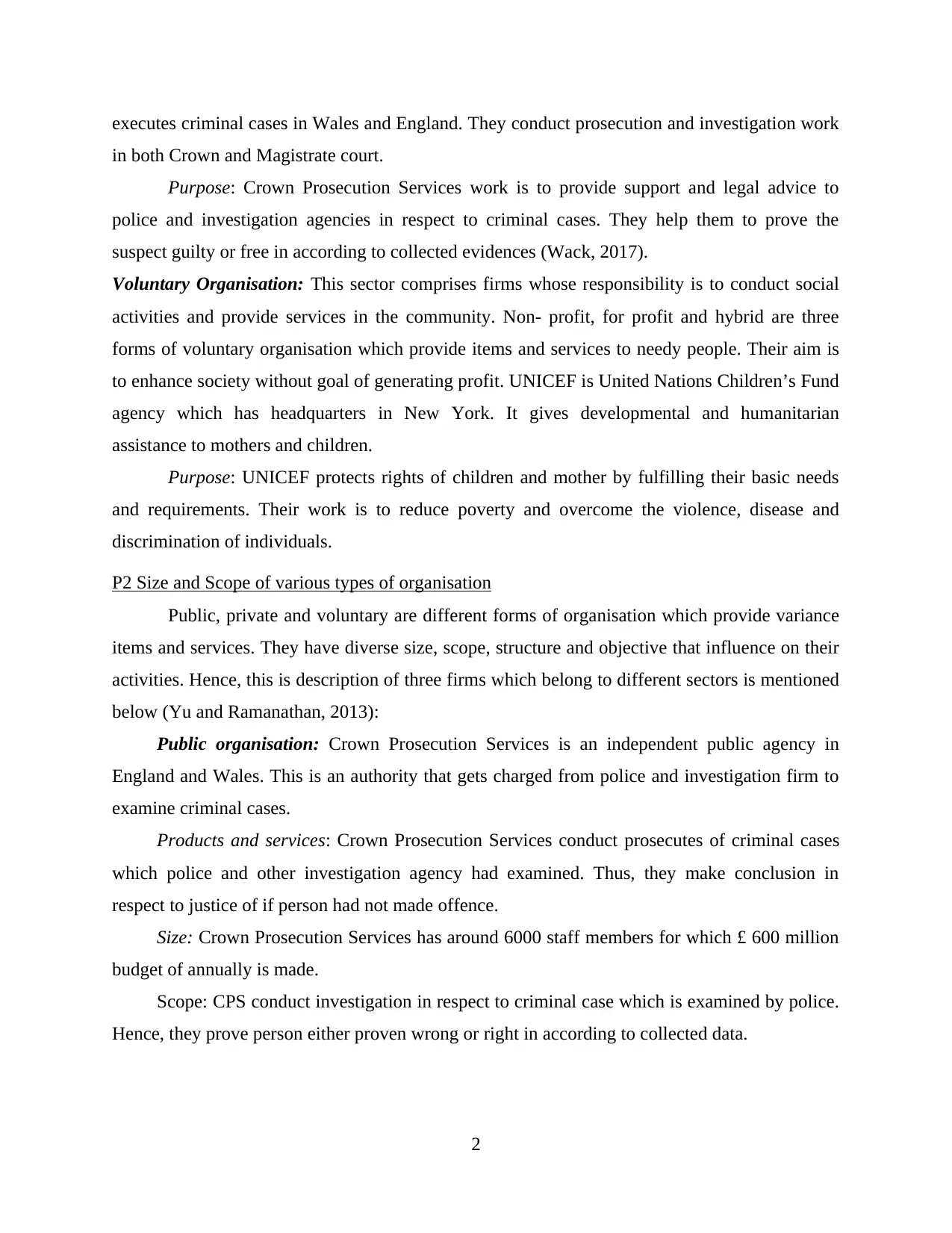
executes criminal cases in Wales and England. They conduct prosecution and investigation work
in both Crown and Magistrate court.
Purpose: Crown Prosecution Services work is to provide support and legal advice to
police and investigation agencies in respect to criminal cases. They help them to prove the
suspect guilty or free in according to collected evidences (Wack, 2017).
Voluntary Organisation: This sector comprises firms whose responsibility is to conduct social
activities and provide services in the community. Non- profit, for profit and hybrid are three
forms of voluntary organisation which provide items and services to needy people. Their aim is
to enhance society without goal of generating profit. UNICEF is United Nations Children’s Fund
agency which has headquarters in New York. It gives developmental and humanitarian
assistance to mothers and children.
Purpose: UNICEF protects rights of children and mother by fulfilling their basic needs
and requirements. Their work is to reduce poverty and overcome the violence, disease and
discrimination of individuals.
P2 Size and Scope of various types of organisation
Public, private and voluntary are different forms of organisation which provide variance
items and services. They have diverse size, scope, structure and objective that influence on their
activities. Hence, this is description of three firms which belong to different sectors is mentioned
below (Yu and Ramanathan, 2013):
Public organisation: Crown Prosecution Services is an independent public agency in
England and Wales. This is an authority that gets charged from police and investigation firm to
examine criminal cases.
Products and services: Crown Prosecution Services conduct prosecutes of criminal cases
which police and other investigation agency had examined. Thus, they make conclusion in
respect to justice of if person had not made offence.
Size: Crown Prosecution Services has around 6000 staff members for which £ 600 million
budget of annually is made.
Scope: CPS conduct investigation in respect to criminal case which is examined by police.
Hence, they prove person either proven wrong or right in according to collected data.
2
in both Crown and Magistrate court.
Purpose: Crown Prosecution Services work is to provide support and legal advice to
police and investigation agencies in respect to criminal cases. They help them to prove the
suspect guilty or free in according to collected evidences (Wack, 2017).
Voluntary Organisation: This sector comprises firms whose responsibility is to conduct social
activities and provide services in the community. Non- profit, for profit and hybrid are three
forms of voluntary organisation which provide items and services to needy people. Their aim is
to enhance society without goal of generating profit. UNICEF is United Nations Children’s Fund
agency which has headquarters in New York. It gives developmental and humanitarian
assistance to mothers and children.
Purpose: UNICEF protects rights of children and mother by fulfilling their basic needs
and requirements. Their work is to reduce poverty and overcome the violence, disease and
discrimination of individuals.
P2 Size and Scope of various types of organisation
Public, private and voluntary are different forms of organisation which provide variance
items and services. They have diverse size, scope, structure and objective that influence on their
activities. Hence, this is description of three firms which belong to different sectors is mentioned
below (Yu and Ramanathan, 2013):
Public organisation: Crown Prosecution Services is an independent public agency in
England and Wales. This is an authority that gets charged from police and investigation firm to
examine criminal cases.
Products and services: Crown Prosecution Services conduct prosecutes of criminal cases
which police and other investigation agency had examined. Thus, they make conclusion in
respect to justice of if person had not made offence.
Size: Crown Prosecution Services has around 6000 staff members for which £ 600 million
budget of annually is made.
Scope: CPS conduct investigation in respect to criminal case which is examined by police.
Hence, they prove person either proven wrong or right in according to collected data.
2
Paraphrase This Document
Need a fresh take? Get an instant paraphrase of this document with our AI Paraphraser
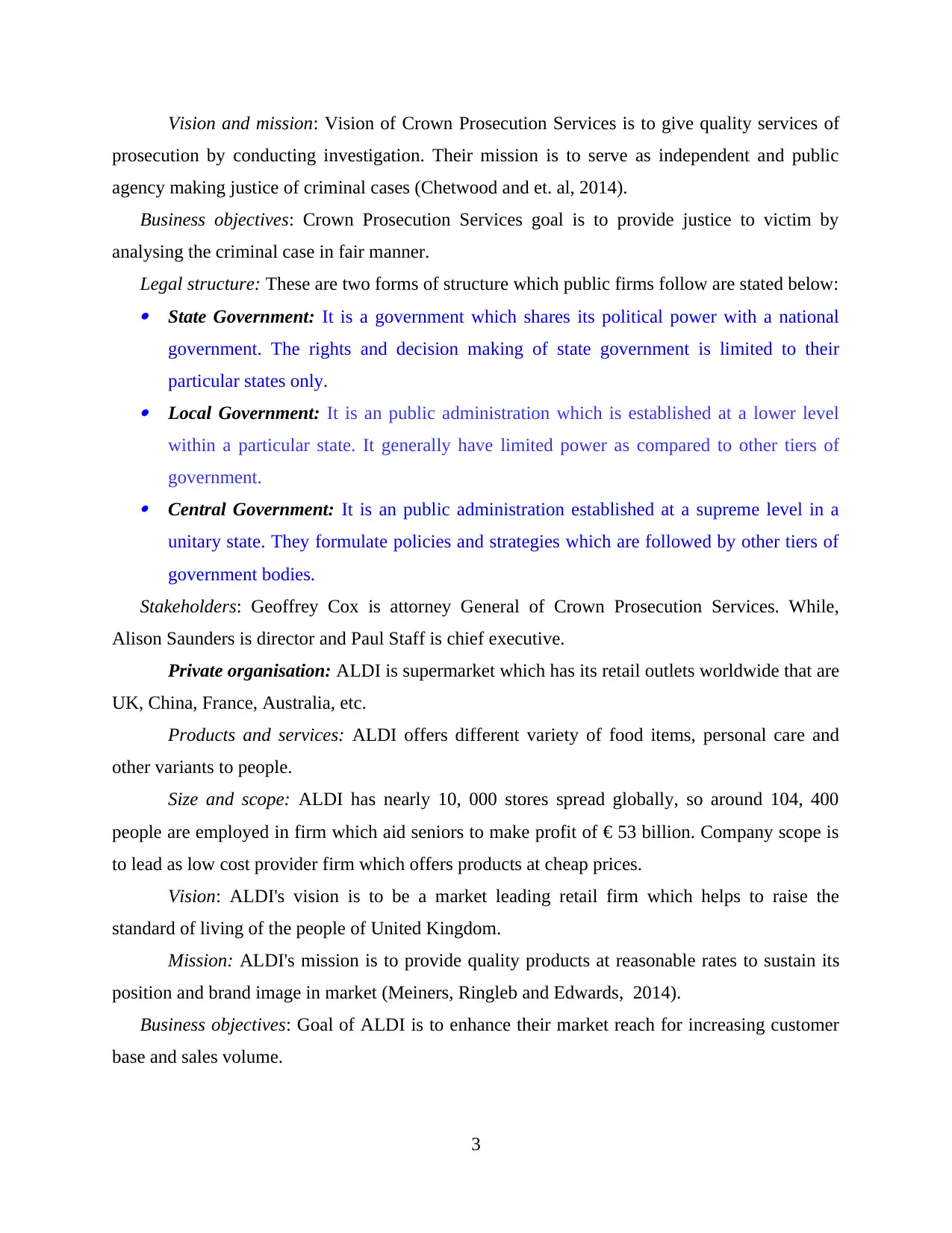
Vision and mission: Vision of Crown Prosecution Services is to give quality services of
prosecution by conducting investigation. Their mission is to serve as independent and public
agency making justice of criminal cases (Chetwood and et. al, 2014).
Business objectives: Crown Prosecution Services goal is to provide justice to victim by
analysing the criminal case in fair manner.
Legal structure: These are two forms of structure which public firms follow are stated below: State Government: It is a government which shares its political power with a national
government. The rights and decision making of state government is limited to their
particular states only. Local Government: It is an public administration which is established at a lower level
within a particular state. It generally have limited power as compared to other tiers of
government. Central Government: It is an public administration established at a supreme level in a
unitary state. They formulate policies and strategies which are followed by other tiers of
government bodies.
Stakeholders: Geoffrey Cox is attorney General of Crown Prosecution Services. While,
Alison Saunders is director and Paul Staff is chief executive.
Private organisation: ALDI is supermarket which has its retail outlets worldwide that are
UK, China, France, Australia, etc.
Products and services: ALDI offers different variety of food items, personal care and
other variants to people.
Size and scope: ALDI has nearly 10, 000 stores spread globally, so around 104, 400
people are employed in firm which aid seniors to make profit of € 53 billion. Company scope is
to lead as low cost provider firm which offers products at cheap prices.
Vision: ALDI's vision is to be a market leading retail firm which helps to raise the
standard of living of the people of United Kingdom.
Mission: ALDI's mission is to provide quality products at reasonable rates to sustain its
position and brand image in market (Meiners, Ringleb and Edwards, 2014).
Business objectives: Goal of ALDI is to enhance their market reach for increasing customer
base and sales volume.
3
prosecution by conducting investigation. Their mission is to serve as independent and public
agency making justice of criminal cases (Chetwood and et. al, 2014).
Business objectives: Crown Prosecution Services goal is to provide justice to victim by
analysing the criminal case in fair manner.
Legal structure: These are two forms of structure which public firms follow are stated below: State Government: It is a government which shares its political power with a national
government. The rights and decision making of state government is limited to their
particular states only. Local Government: It is an public administration which is established at a lower level
within a particular state. It generally have limited power as compared to other tiers of
government. Central Government: It is an public administration established at a supreme level in a
unitary state. They formulate policies and strategies which are followed by other tiers of
government bodies.
Stakeholders: Geoffrey Cox is attorney General of Crown Prosecution Services. While,
Alison Saunders is director and Paul Staff is chief executive.
Private organisation: ALDI is supermarket which has its retail outlets worldwide that are
UK, China, France, Australia, etc.
Products and services: ALDI offers different variety of food items, personal care and
other variants to people.
Size and scope: ALDI has nearly 10, 000 stores spread globally, so around 104, 400
people are employed in firm which aid seniors to make profit of € 53 billion. Company scope is
to lead as low cost provider firm which offers products at cheap prices.
Vision: ALDI's vision is to be a market leading retail firm which helps to raise the
standard of living of the people of United Kingdom.
Mission: ALDI's mission is to provide quality products at reasonable rates to sustain its
position and brand image in market (Meiners, Ringleb and Edwards, 2014).
Business objectives: Goal of ALDI is to enhance their market reach for increasing customer
base and sales volume.
3

Legal structure: These are three types of structure which are followed by public firms are
described beneath: Sole proprietorship: Firms which are started and manage by single person for generating
revenue for their livelihood. Painter, carpenter, dresser, grocery person and many other
are sole trading enterprises. They didn’t require sharing decision making rights and
profits, as there are no members. But, entrepreneur has unlimited liability which effect on
resources that is funds, material and manpower. Thus, business activities are impacted
and delivery of products and services (Sekaran and Bougie 2016). Partnership: Companies which incorporated by two or more people which enter into
agreement. Partnership deed is signed by all partners in which their rights and power are
specifies. This helps in systematic decision making and conflicts are overcome by
defining each partner rights.
Stakeholders: Siepmann Foundation (ALDI Sud) and Markus Foundation (ALDI Nord) are
proprietor of ALDI.
Voluntary organisation: UNICEF is United Nations agency which provides development
and humanitarian support to mother and children.
Products and services: UNICEF frame policies and protect rights of children and mother
for enhancement of nation.
Size and scope: UNICEF established in 1946 that is 71 years ago for protecting rights of
mother and children.
Vision and mission: UNICEF mission is protecting rights of children mother by fulfilling
their basic needs. There is vision is to enhance opportunities to attain their full potential for
development of nation (Saleem, 2017).
Business objectives: UNICEF goal is to promote programmes in respect to equality of
girls and women in political, social and economic sector of country.
Stakeholders: Tore Hattrem is president of UNICEF and Henrietta H. Fore is executive
director.
4
described beneath: Sole proprietorship: Firms which are started and manage by single person for generating
revenue for their livelihood. Painter, carpenter, dresser, grocery person and many other
are sole trading enterprises. They didn’t require sharing decision making rights and
profits, as there are no members. But, entrepreneur has unlimited liability which effect on
resources that is funds, material and manpower. Thus, business activities are impacted
and delivery of products and services (Sekaran and Bougie 2016). Partnership: Companies which incorporated by two or more people which enter into
agreement. Partnership deed is signed by all partners in which their rights and power are
specifies. This helps in systematic decision making and conflicts are overcome by
defining each partner rights.
Stakeholders: Siepmann Foundation (ALDI Sud) and Markus Foundation (ALDI Nord) are
proprietor of ALDI.
Voluntary organisation: UNICEF is United Nations agency which provides development
and humanitarian support to mother and children.
Products and services: UNICEF frame policies and protect rights of children and mother
for enhancement of nation.
Size and scope: UNICEF established in 1946 that is 71 years ago for protecting rights of
mother and children.
Vision and mission: UNICEF mission is protecting rights of children mother by fulfilling
their basic needs. There is vision is to enhance opportunities to attain their full potential for
development of nation (Saleem, 2017).
Business objectives: UNICEF goal is to promote programmes in respect to equality of
girls and women in political, social and economic sector of country.
Stakeholders: Tore Hattrem is president of UNICEF and Henrietta H. Fore is executive
director.
4
⊘ This is a preview!⊘
Do you want full access?
Subscribe today to unlock all pages.

Trusted by 1+ million students worldwide
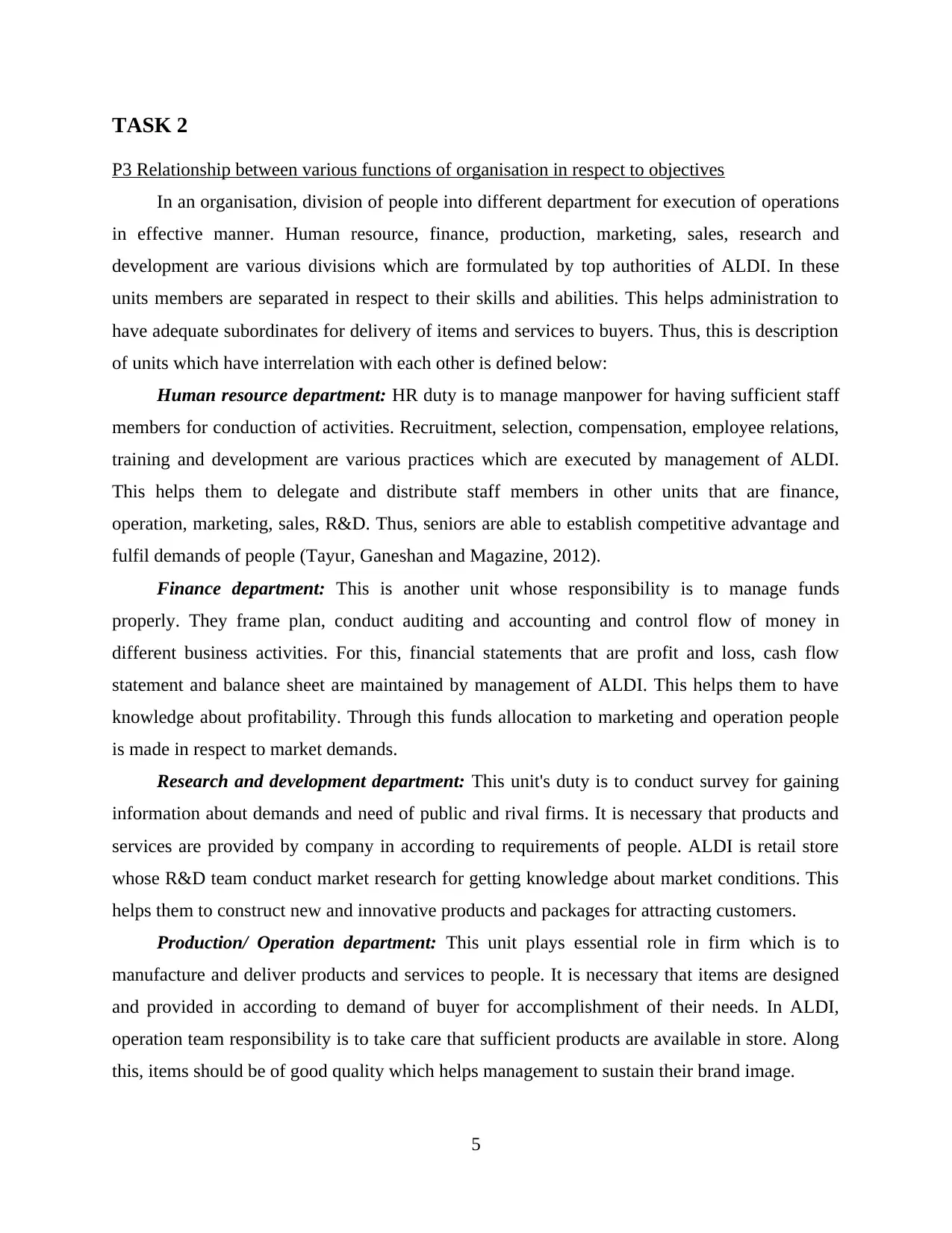
TASK 2
P3 Relationship between various functions of organisation in respect to objectives
In an organisation, division of people into different department for execution of operations
in effective manner. Human resource, finance, production, marketing, sales, research and
development are various divisions which are formulated by top authorities of ALDI. In these
units members are separated in respect to their skills and abilities. This helps administration to
have adequate subordinates for delivery of items and services to buyers. Thus, this is description
of units which have interrelation with each other is defined below:
Human resource department: HR duty is to manage manpower for having sufficient staff
members for conduction of activities. Recruitment, selection, compensation, employee relations,
training and development are various practices which are executed by management of ALDI.
This helps them to delegate and distribute staff members in other units that are finance,
operation, marketing, sales, R&D. Thus, seniors are able to establish competitive advantage and
fulfil demands of people (Tayur, Ganeshan and Magazine, 2012).
Finance department: This is another unit whose responsibility is to manage funds
properly. They frame plan, conduct auditing and accounting and control flow of money in
different business activities. For this, financial statements that are profit and loss, cash flow
statement and balance sheet are maintained by management of ALDI. This helps them to have
knowledge about profitability. Through this funds allocation to marketing and operation people
is made in respect to market demands.
Research and development department: This unit's duty is to conduct survey for gaining
information about demands and need of public and rival firms. It is necessary that products and
services are provided by company in according to requirements of people. ALDI is retail store
whose R&D team conduct market research for getting knowledge about market conditions. This
helps them to construct new and innovative products and packages for attracting customers.
Production/ Operation department: This unit plays essential role in firm which is to
manufacture and deliver products and services to people. It is necessary that items are designed
and provided in according to demand of buyer for accomplishment of their needs. In ALDI,
operation team responsibility is to take care that sufficient products are available in store. Along
this, items should be of good quality which helps management to sustain their brand image.
5
P3 Relationship between various functions of organisation in respect to objectives
In an organisation, division of people into different department for execution of operations
in effective manner. Human resource, finance, production, marketing, sales, research and
development are various divisions which are formulated by top authorities of ALDI. In these
units members are separated in respect to their skills and abilities. This helps administration to
have adequate subordinates for delivery of items and services to buyers. Thus, this is description
of units which have interrelation with each other is defined below:
Human resource department: HR duty is to manage manpower for having sufficient staff
members for conduction of activities. Recruitment, selection, compensation, employee relations,
training and development are various practices which are executed by management of ALDI.
This helps them to delegate and distribute staff members in other units that are finance,
operation, marketing, sales, R&D. Thus, seniors are able to establish competitive advantage and
fulfil demands of people (Tayur, Ganeshan and Magazine, 2012).
Finance department: This is another unit whose responsibility is to manage funds
properly. They frame plan, conduct auditing and accounting and control flow of money in
different business activities. For this, financial statements that are profit and loss, cash flow
statement and balance sheet are maintained by management of ALDI. This helps them to have
knowledge about profitability. Through this funds allocation to marketing and operation people
is made in respect to market demands.
Research and development department: This unit's duty is to conduct survey for gaining
information about demands and need of public and rival firms. It is necessary that products and
services are provided by company in according to requirements of people. ALDI is retail store
whose R&D team conduct market research for getting knowledge about market conditions. This
helps them to construct new and innovative products and packages for attracting customers.
Production/ Operation department: This unit plays essential role in firm which is to
manufacture and deliver products and services to people. It is necessary that items are designed
and provided in according to demand of buyer for accomplishment of their needs. In ALDI,
operation team responsibility is to take care that sufficient products are available in store. Along
this, items should be of good quality which helps management to sustain their brand image.
5
Paraphrase This Document
Need a fresh take? Get an instant paraphrase of this document with our AI Paraphraser
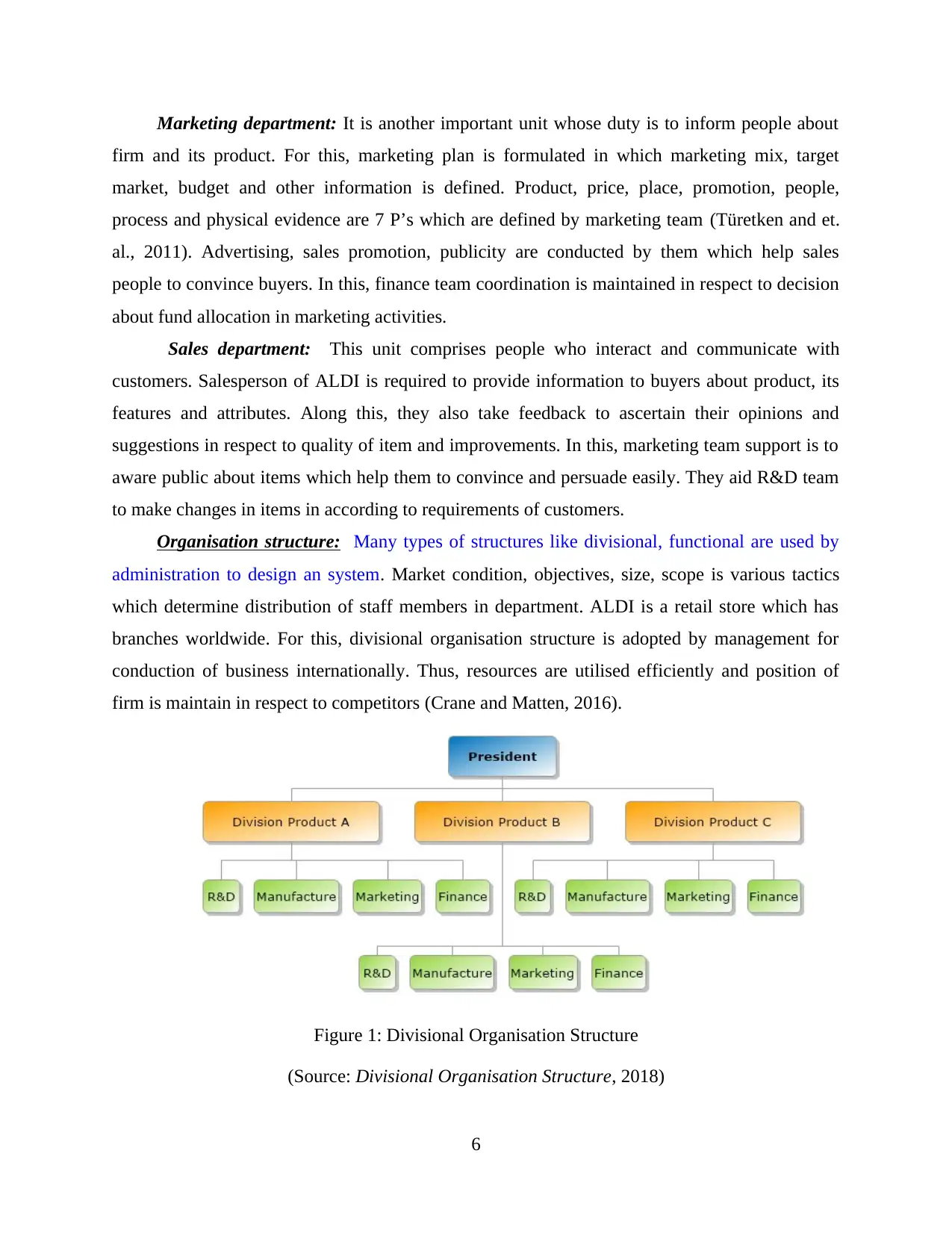
Marketing department: It is another important unit whose duty is to inform people about
firm and its product. For this, marketing plan is formulated in which marketing mix, target
market, budget and other information is defined. Product, price, place, promotion, people,
process and physical evidence are 7 P’s which are defined by marketing team (Türetken and et.
al., 2011). Advertising, sales promotion, publicity are conducted by them which help sales
people to convince buyers. In this, finance team coordination is maintained in respect to decision
about fund allocation in marketing activities.
Sales department: This unit comprises people who interact and communicate with
customers. Salesperson of ALDI is required to provide information to buyers about product, its
features and attributes. Along this, they also take feedback to ascertain their opinions and
suggestions in respect to quality of item and improvements. In this, marketing team support is to
aware public about items which help them to convince and persuade easily. They aid R&D team
to make changes in items in according to requirements of customers.
Organisation structure: Many types of structures like divisional, functional are used by
administration to design an system. Market condition, objectives, size, scope is various tactics
which determine distribution of staff members in department. ALDI is a retail store which has
branches worldwide. For this, divisional organisation structure is adopted by management for
conduction of business internationally. Thus, resources are utilised efficiently and position of
firm is maintain in respect to competitors (Crane and Matten, 2016).
Figure 1: Divisional Organisation Structure
(Source: Divisional Organisation Structure, 2018)
6
firm and its product. For this, marketing plan is formulated in which marketing mix, target
market, budget and other information is defined. Product, price, place, promotion, people,
process and physical evidence are 7 P’s which are defined by marketing team (Türetken and et.
al., 2011). Advertising, sales promotion, publicity are conducted by them which help sales
people to convince buyers. In this, finance team coordination is maintained in respect to decision
about fund allocation in marketing activities.
Sales department: This unit comprises people who interact and communicate with
customers. Salesperson of ALDI is required to provide information to buyers about product, its
features and attributes. Along this, they also take feedback to ascertain their opinions and
suggestions in respect to quality of item and improvements. In this, marketing team support is to
aware public about items which help them to convince and persuade easily. They aid R&D team
to make changes in items in according to requirements of customers.
Organisation structure: Many types of structures like divisional, functional are used by
administration to design an system. Market condition, objectives, size, scope is various tactics
which determine distribution of staff members in department. ALDI is a retail store which has
branches worldwide. For this, divisional organisation structure is adopted by management for
conduction of business internationally. Thus, resources are utilised efficiently and position of
firm is maintain in respect to competitors (Crane and Matten, 2016).
Figure 1: Divisional Organisation Structure
(Source: Divisional Organisation Structure, 2018)
6
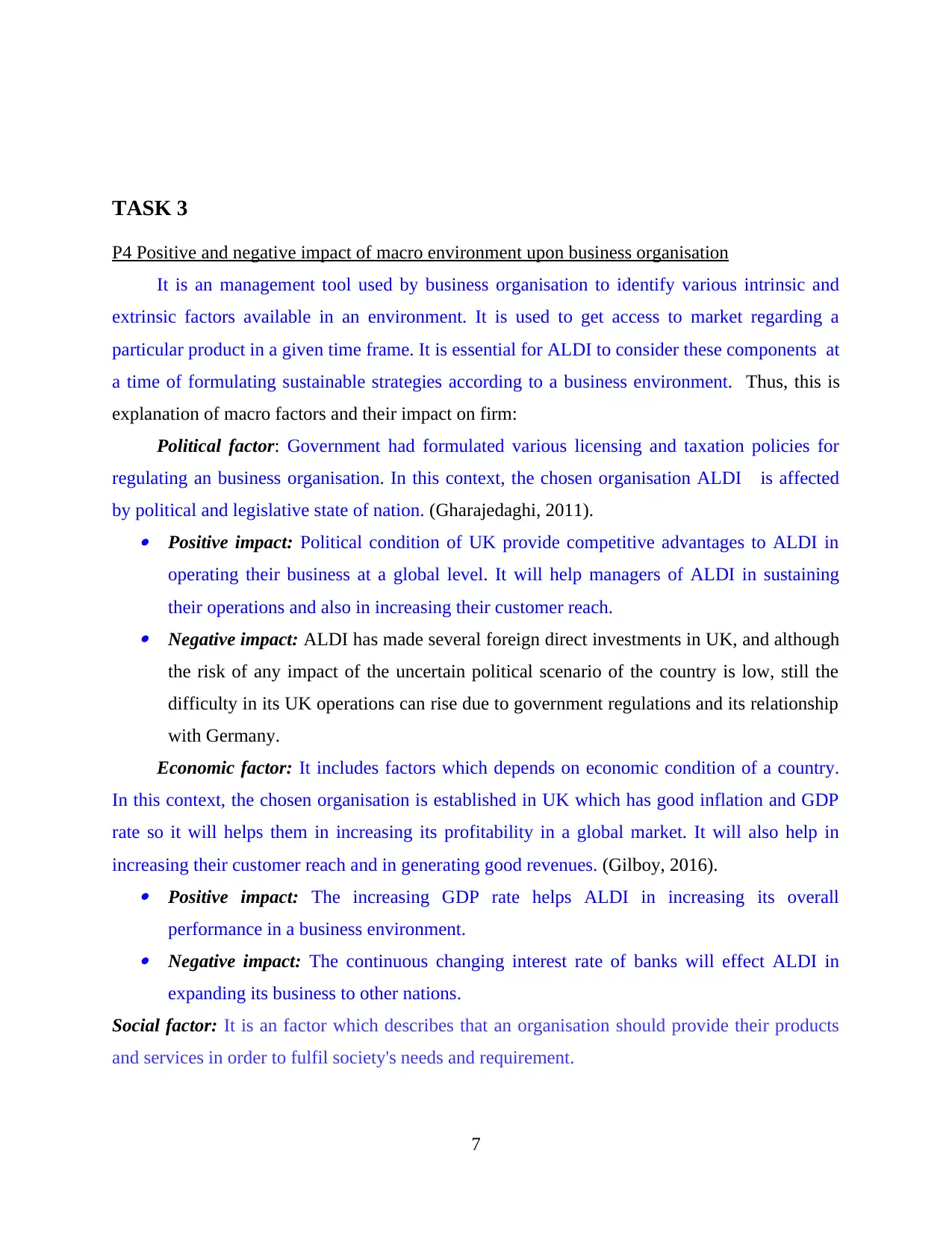
TASK 3
P4 Positive and negative impact of macro environment upon business organisation
It is an management tool used by business organisation to identify various intrinsic and
extrinsic factors available in an environment. It is used to get access to market regarding a
particular product in a given time frame. It is essential for ALDI to consider these components at
a time of formulating sustainable strategies according to a business environment. Thus, this is
explanation of macro factors and their impact on firm:
Political factor: Government had formulated various licensing and taxation policies for
regulating an business organisation. In this context, the chosen organisation ALDI is affected
by political and legislative state of nation. (Gharajedaghi, 2011). Positive impact: Political condition of UK provide competitive advantages to ALDI in
operating their business at a global level. It will help managers of ALDI in sustaining
their operations and also in increasing their customer reach. Negative impact: ALDI has made several foreign direct investments in UK, and although
the risk of any impact of the uncertain political scenario of the country is low, still the
difficulty in its UK operations can rise due to government regulations and its relationship
with Germany.
Economic factor: It includes factors which depends on economic condition of a country.
In this context, the chosen organisation is established in UK which has good inflation and GDP
rate so it will helps them in increasing its profitability in a global market. It will also help in
increasing their customer reach and in generating good revenues. (Gilboy, 2016). Positive impact: The increasing GDP rate helps ALDI in increasing its overall
performance in a business environment. Negative impact: The continuous changing interest rate of banks will effect ALDI in
expanding its business to other nations.
Social factor: It is an factor which describes that an organisation should provide their products
and services in order to fulfil society's needs and requirement.
7
P4 Positive and negative impact of macro environment upon business organisation
It is an management tool used by business organisation to identify various intrinsic and
extrinsic factors available in an environment. It is used to get access to market regarding a
particular product in a given time frame. It is essential for ALDI to consider these components at
a time of formulating sustainable strategies according to a business environment. Thus, this is
explanation of macro factors and their impact on firm:
Political factor: Government had formulated various licensing and taxation policies for
regulating an business organisation. In this context, the chosen organisation ALDI is affected
by political and legislative state of nation. (Gharajedaghi, 2011). Positive impact: Political condition of UK provide competitive advantages to ALDI in
operating their business at a global level. It will help managers of ALDI in sustaining
their operations and also in increasing their customer reach. Negative impact: ALDI has made several foreign direct investments in UK, and although
the risk of any impact of the uncertain political scenario of the country is low, still the
difficulty in its UK operations can rise due to government regulations and its relationship
with Germany.
Economic factor: It includes factors which depends on economic condition of a country.
In this context, the chosen organisation is established in UK which has good inflation and GDP
rate so it will helps them in increasing its profitability in a global market. It will also help in
increasing their customer reach and in generating good revenues. (Gilboy, 2016). Positive impact: The increasing GDP rate helps ALDI in increasing its overall
performance in a business environment. Negative impact: The continuous changing interest rate of banks will effect ALDI in
expanding its business to other nations.
Social factor: It is an factor which describes that an organisation should provide their products
and services in order to fulfil society's needs and requirement.
7
⊘ This is a preview!⊘
Do you want full access?
Subscribe today to unlock all pages.

Trusted by 1+ million students worldwide
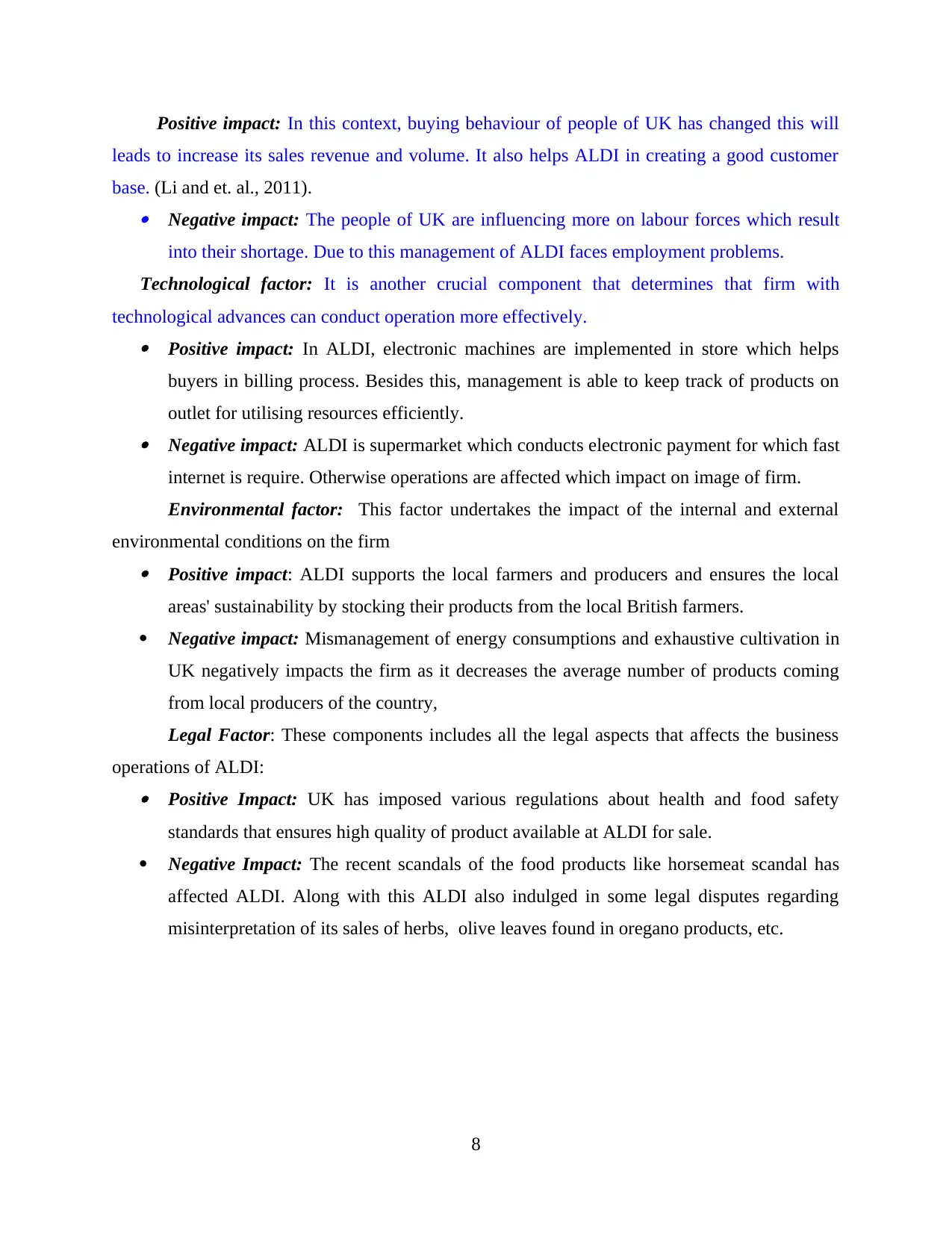
Positive impact: In this context, buying behaviour of people of UK has changed this will
leads to increase its sales revenue and volume. It also helps ALDI in creating a good customer
base. (Li and et. al., 2011). Negative impact: The people of UK are influencing more on labour forces which result
into their shortage. Due to this management of ALDI faces employment problems.
Technological factor: It is another crucial component that determines that firm with
technological advances can conduct operation more effectively. Positive impact: In ALDI, electronic machines are implemented in store which helps
buyers in billing process. Besides this, management is able to keep track of products on
outlet for utilising resources efficiently. Negative impact: ALDI is supermarket which conducts electronic payment for which fast
internet is require. Otherwise operations are affected which impact on image of firm.
Environmental factor: This factor undertakes the impact of the internal and external
environmental conditions on the firm Positive impact: ALDI supports the local farmers and producers and ensures the local
areas' sustainability by stocking their products from the local British farmers.
Negative impact: Mismanagement of energy consumptions and exhaustive cultivation in
UK negatively impacts the firm as it decreases the average number of products coming
from local producers of the country,
Legal Factor: These components includes all the legal aspects that affects the business
operations of ALDI: Positive Impact: UK has imposed various regulations about health and food safety
standards that ensures high quality of product available at ALDI for sale.
Negative Impact: The recent scandals of the food products like horsemeat scandal has
affected ALDI. Along with this ALDI also indulged in some legal disputes regarding
misinterpretation of its sales of herbs, olive leaves found in oregano products, etc.
8
leads to increase its sales revenue and volume. It also helps ALDI in creating a good customer
base. (Li and et. al., 2011). Negative impact: The people of UK are influencing more on labour forces which result
into their shortage. Due to this management of ALDI faces employment problems.
Technological factor: It is another crucial component that determines that firm with
technological advances can conduct operation more effectively. Positive impact: In ALDI, electronic machines are implemented in store which helps
buyers in billing process. Besides this, management is able to keep track of products on
outlet for utilising resources efficiently. Negative impact: ALDI is supermarket which conducts electronic payment for which fast
internet is require. Otherwise operations are affected which impact on image of firm.
Environmental factor: This factor undertakes the impact of the internal and external
environmental conditions on the firm Positive impact: ALDI supports the local farmers and producers and ensures the local
areas' sustainability by stocking their products from the local British farmers.
Negative impact: Mismanagement of energy consumptions and exhaustive cultivation in
UK negatively impacts the firm as it decreases the average number of products coming
from local producers of the country,
Legal Factor: These components includes all the legal aspects that affects the business
operations of ALDI: Positive Impact: UK has imposed various regulations about health and food safety
standards that ensures high quality of product available at ALDI for sale.
Negative Impact: The recent scandals of the food products like horsemeat scandal has
affected ALDI. Along with this ALDI also indulged in some legal disputes regarding
misinterpretation of its sales of herbs, olive leaves found in oregano products, etc.
8
Paraphrase This Document
Need a fresh take? Get an instant paraphrase of this document with our AI Paraphraser

(Sources: What is PEST Analysis?, 2018)
TASK 4
P5 Internal and External analysis to strengths and weakness of organisation
SWOT analysis is strategy which is mainly use by management of an organisation in
order to investigate competitive position of firm. With help of this model, strength of system can
be analysed by seniors of ALDI to utilize market opportunities. Some major threats and
weakness are determined to prevent and decrease them from affecting business operations and
market image (Zeng, Li and Duan, 2012).
SWOT Analysis of ALDI:
Figure 2: SWOT Analysis
9
Illustration 1: What is PEST Analysis?, 2018
TASK 4
P5 Internal and External analysis to strengths and weakness of organisation
SWOT analysis is strategy which is mainly use by management of an organisation in
order to investigate competitive position of firm. With help of this model, strength of system can
be analysed by seniors of ALDI to utilize market opportunities. Some major threats and
weakness are determined to prevent and decrease them from affecting business operations and
market image (Zeng, Li and Duan, 2012).
SWOT Analysis of ALDI:
Figure 2: SWOT Analysis
9
Illustration 1: What is PEST Analysis?, 2018

(Source: SWOT Analysis, 2018)
Strengths Weaknesses
ALDI is famous retail firm which
provide quality items at reasonable
rates. They offer variety of products
that are food, personal care and
home appliances.
There are 10,000 outlets around the
globe which can help organisation
to acquire large market reach and
customer base.
ALDI generally offer their
products at discounts and cheap
prices which help their management
to develop successful business and
sustain fo long time.
ALDI is basically small sacle and
have few stores as compared to
others.
Company provide products at cheap
prices which determine that quality of
items are not so good.
ALDI sell items at low rates, so
company profit depend on sales
volume.
Management are not able to provide
adequate amount of salary to their
employees according to their
working. This can produce high
dissatisfaction and will impact on
their performance level.
Opportunities Threats
Management of ALDI require
increasing their spending in
advertisement for competing
competitors.
Enlarge store in other nations that
are Asia, Africa and many other.
ALDI require repositioning image
of its brand in more affordable
manner than company can provide
items in cheap rates . This will help
seniors to increase business and
revenue.
Morrisons, ASDA and LIDL are
various rival firms of ALDI.
ALDI doesn’t provide all variety of
items, so buyers are not able to gain
complete shopping experience at one
outlet.
Changes in government taxation and
policies will impact on business of
ALDI. (Sekaran and Bougie 2016).
10
Strengths Weaknesses
ALDI is famous retail firm which
provide quality items at reasonable
rates. They offer variety of products
that are food, personal care and
home appliances.
There are 10,000 outlets around the
globe which can help organisation
to acquire large market reach and
customer base.
ALDI generally offer their
products at discounts and cheap
prices which help their management
to develop successful business and
sustain fo long time.
ALDI is basically small sacle and
have few stores as compared to
others.
Company provide products at cheap
prices which determine that quality of
items are not so good.
ALDI sell items at low rates, so
company profit depend on sales
volume.
Management are not able to provide
adequate amount of salary to their
employees according to their
working. This can produce high
dissatisfaction and will impact on
their performance level.
Opportunities Threats
Management of ALDI require
increasing their spending in
advertisement for competing
competitors.
Enlarge store in other nations that
are Asia, Africa and many other.
ALDI require repositioning image
of its brand in more affordable
manner than company can provide
items in cheap rates . This will help
seniors to increase business and
revenue.
Morrisons, ASDA and LIDL are
various rival firms of ALDI.
ALDI doesn’t provide all variety of
items, so buyers are not able to gain
complete shopping experience at one
outlet.
Changes in government taxation and
policies will impact on business of
ALDI. (Sekaran and Bougie 2016).
10
⊘ This is a preview!⊘
Do you want full access?
Subscribe today to unlock all pages.

Trusted by 1+ million students worldwide
1 out of 15
Related Documents
Your All-in-One AI-Powered Toolkit for Academic Success.
+13062052269
info@desklib.com
Available 24*7 on WhatsApp / Email
![[object Object]](/_next/static/media/star-bottom.7253800d.svg)
Unlock your academic potential
Copyright © 2020–2025 A2Z Services. All Rights Reserved. Developed and managed by ZUCOL.





